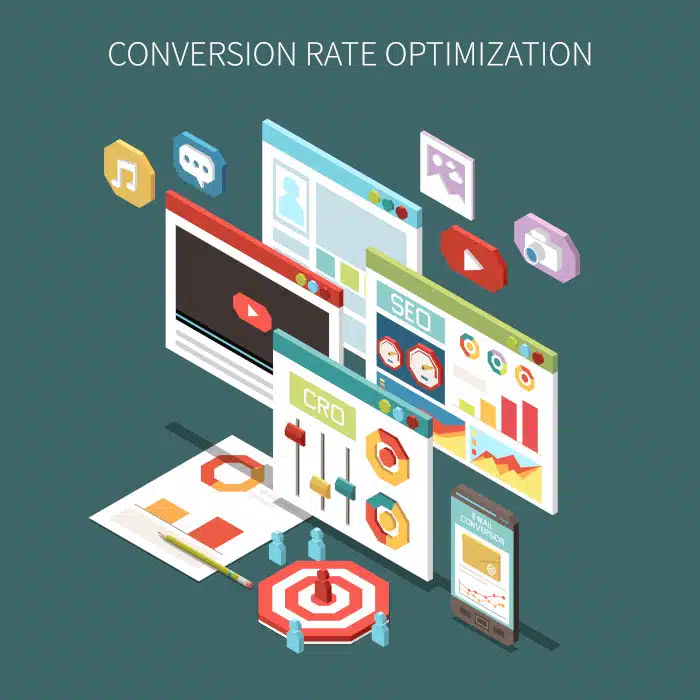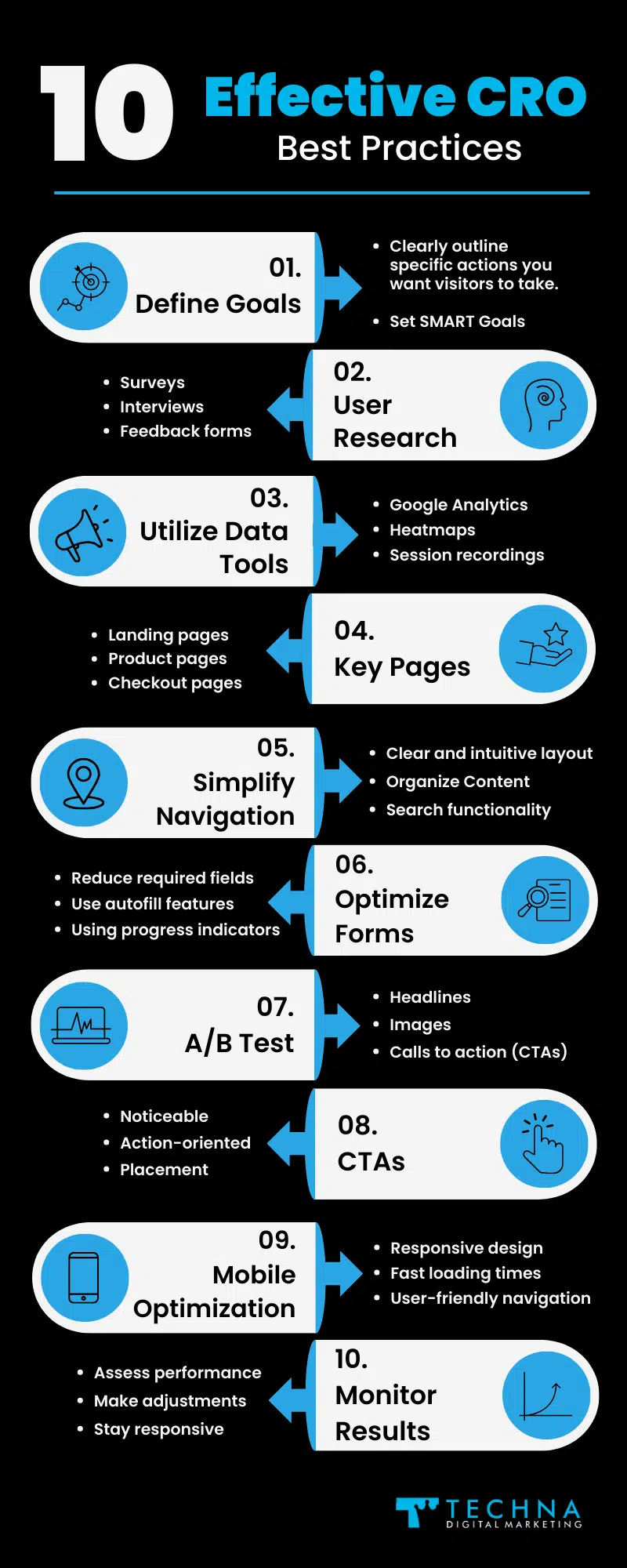Key Takeaways
- Establish specific, measurable actions you want users to take on your website. This foundation helps guide your optimization strategies and assess their success.
- Utilize tools like Google Analytics and heatmaps to analyze how visitors interact with your site. Understanding user behavior reveals preferences and pain points that can inform necessary changes.
- Common obstacles such as complicated navigation, slow loading times, unclear calls to action, and poor mobile experiences can hinder conversions. Identifying these barriers is crucial for improvement.
- Use A/B testing to experiment with different elements of your website, such as headlines and CTAs. Data-driven insights from these tests guide effective changes that enhance user engagement and conversion rates.
- CRO is an ongoing process that requires regular review of metrics and user feedback. Adapting to changes in user behavior and market conditions helps maintain and improve conversion rates over time.
Understanding Conversion Rate Optimization (CRO)
Conversion Rate Optimization (CRO) is a systematic approach to increasing the percentage of website visitors who take a desired action. This action could be anything from making a purchase, signing up for a newsletter, filling out a contact form, or downloading a resource. Essentially, CRO focuses on turning more of your existing traffic into leads or customers, maximizing the effectiveness of your marketing efforts.
Key Components of CRO
Knowing the definition of CRO is just the start. One of the most important parts of understanding CRO is knowing what factors and components influence CRO and what they mean in relation to it. Find out the key components below.
1. Understanding Conversions
A conversion refers to any desired action that you want your visitors to take on your website. This could range from making a purchase, signing up for a newsletter, filling out a contact form, downloading a resource, or any other action that signifies engagement with your brand. Clearly defining what a conversion means for your business is crucial, as it sets the foundation for your optimization strategies. For example, if your primary goal is to increase sales, you will focus on optimizing product pages and checkout processes.
2. Analyzing User Behavior
To effectively optimize conversion rates, it is essential to understand how users interact with your site. Tools like Google Analytics provide valuable data on user behavior, such as the number of visitors, bounce rates, average session duration, and user flow through your site. Heatmaps can visually represent where visitors are clicking and how they navigate each page, allowing you to see which elements draw attention and what they ignore. By analyzing this data, you can gain insights into user preferences and pain points, helping you make informed decisions on changes needed to enhance the user experience.
3. Identifying Barriers
After gaining insights into user behavior, the next step is to identify barriers that may be hindering conversions. Common obstacles include:
- Complicated Navigation: If users struggle to find what they are looking for due to a confusing menu structure, they are likely to leave your site without converting.
- Slow Loading Times: Websites that load slowly can frustrate users and lead to high bounce rates. Studies show that even a one-second delay can negatively impact conversions.
- Unclear Calls to Action (CTAs): If CTAs are vague or hard to find, users may not know what action to take next. Clear and compelling CTAs guide users toward conversions.
- Poor Mobile Experience: With an increasing number of users accessing websites on mobile devices, ensuring a seamless mobile experience is critical. If your site is not mobile-friendly, you risk losing potential conversions.
4. Testing and Experimentation
A key component of CRO is testing different elements of your website using A/B testing. This method involves creating two versions of a web page (Version A and Version B) and comparing their performance to determine which version results in higher conversion rates. You can test various elements, such as:
- Headlines: The words used in headlines can significantly influence visitor engagement.
- Images: Different images can evoke various emotional responses and impact user decisions.
- Layout: The arrangement of content can affect readability and usability.
- CTAs: Testing different colors, sizes, and placements of CTAs can improve their visibility and increase click-through rates.
Through systematic experimentation, you can learn what resonates most with your audience and refine your website accordingly.
5. Making Data-Driven Changes
The insights gained from user behavior analysis and testing provide a strong basis for making data-driven changes to your website. Potential changes might include:
- Redesigning Landing Pages: An appealing and functional landing page can significantly increase conversions.
- Simplifying Forms: Reducing the number of fields in forms can make it easier for users to complete them, thereby increasing submission rates.
- Adjusting Messaging: Tailoring messaging to better align with user needs or preferences can enhance engagement and drive conversions.
By focusing on data rather than assumptions, you can implement changes that have a greater likelihood of success.
6. Continuous Improvement
Conversion rate optimization is not a one-time project; it is an ongoing process. Regularly reviewing performance metrics and gathering user feedback allows you to refine your approach continuously. This may involve re-evaluating your goals as market conditions change or as new trends emerge. By staying adaptable and responsive to user behavior shifts, you can maintain and even improve conversion rates over time.
Benefits of CRO
Investing in Conversion Rate Optimization (CRO) offers numerous advantages that can significantly impact a business’s success. In a competitive marketplace where every visitor has the potential to become a customer, optimizing conversion rates can lead to substantial benefits. Below are some benefits of implementing CRO, each of which provides unique opportunities for growth and improvement.
1. Increased Revenue
By improving conversion rates, businesses can significantly boost their revenue without the need to attract new visitors. This means that even a small increase in conversion rates can lead to substantial financial gains. For example, if an e-commerce site with a 2% conversion rate improves to 3%, it could see a 50% increase in sales from the same amount of traffic.
2. Enhanced User Experience
CRO often involves making changes that directly improve the user experience. This can include simplifying navigation, reducing loading times, and ensuring that content is relevant and engaging. By addressing common pain points, users are more likely to have a positive interaction with the website, which can result in increased customer satisfaction and loyalty. A better user experience can also lead to positive word-of-mouth referrals, further boosting traffic.
3. Cost Efficiency
Investing in CRO can be more cost-effective than continually seeking new traffic sources. With CRO, businesses focus on maximizing their current marketing efforts and converting existing visitors into customers. This strategy reduces reliance on paid ads or other costly methods to drive traffic, leading to better returns on existing marketing investments.
4. Competitive Advantage
Companies that prioritize CRO have the potential to outperform their competitors. By converting more visitors into customers, these businesses can build a stronger market position. Enhanced conversion rates can lead to increased market share and brand recognition, allowing companies to establish themselves as leaders in their industries. Furthermore, a well-optimized website can attract organic traffic, enhancing visibility in search engine results.
5. Better Understanding of Customers
CRO processes often involve collecting and analyzing data about user behavior on the website. This data can provide valuable insights into customer preferences, motivations, and pain points. Understanding these factors enables businesses to tailor their offerings and marketing strategies more effectively, leading to improved customer engagement and higher conversion rates.
6. Long-Term Growth
Focusing on CRO is not only about immediate gains; it contributes to long-term business growth. By continuously optimizing the user experience and adapting to customer feedback, businesses can build sustainable relationships with their audience. Over time, this commitment to improvement fosters brand loyalty and encourages repeat purchases.
7. Enhanced Marketing ROI
With higher conversion rates, the return on investment (ROI) for marketing campaigns improves significantly. Whether it is through email marketing, social media ads, or content marketing, optimized conversion rates allow businesses to make the most of their marketing budgets. This efficiency means that every dollar spent on marketing drives more revenue, making it easier for companies to scale their efforts.
How to Implement Effective CRO
Implementing effective Conversion Rate Optimization (CRO) involves a systematic approach that leverages data and user insights to enhance the performance of your website. Here is an expanded guide on how to implement effective CRO strategies:
1. Define Your Goals
Start by clearly defining what you want to achieve with your CRO efforts. This involves identifying specific actions you want visitors to take on your site, such as making a purchase, signing up for a newsletter, or downloading a resource. Set measurable goals, like increasing the conversion rate by a certain percentage within a specified timeframe. Having clear goals not only provides direction for your efforts but also helps in evaluating the success of your strategies.
2. Conduct User Research
Gathering insights directly from users is crucial to understanding their motivations, behaviors, and pain points. Utilize methods such as surveys, interviews, and feedback forms to collect qualitative data. Ask questions that reveal what users appreciate about your site, where they encounter obstacles, and what would make their experience better. This information will be invaluable in shaping your optimization strategies and ensuring they align with user needs and expectations.
3. Utilize Analytics Tools
Leverage analytics tools like Google Analytics, heatmaps, and session recordings to monitor user behavior on your site. Analyze data to look for patterns and trends that indicate where users are struggling or excelling. For instance, identify which pages have high bounce rates or where users drop off during the conversion process. Understanding this behavior allows you to pinpoint specific areas that require attention and improvement.
4. Focus on Key Pages
Identify the pages that are most important for conversions, such as landing pages, product pages, and checkout pages. Prioritize these pages for your optimization efforts since they play a critical role in the user journey. Analyze their performance and make targeted improvements to enhance their effectiveness in guiding users toward completing desired actions.
5. Simplify Navigation
Ensure that your website is easy to navigate. A clear and intuitive layout helps users find what they are looking for quickly, reducing the chances of drop-off. Organize content logically, use descriptive labels for menu items, and implement a search function to assist users in locating information efficiently. A seamless navigation experience can significantly enhance user satisfaction and encourage conversions.
6. Optimize Forms
If your conversion process involves forms—such as signup or checkout forms—focus on making them as user-friendly as possible. Reduce the number of fields required to complete the form, as lengthy forms can deter users from finishing the process. Consider incorporating features like autofill options and progress indicators for longer forms to streamline the experience. Testing different form designs can also help identify which formats yield higher completion rates.
7. A/B Testing
Regularly conduct A/B tests on various elements of your site—such as headlines, images, calls to action (CTAs), and overall layout—to determine what combinations yield the best results. By comparing two versions of a page or element, you can gain insights into user preferences and behaviors. Keep in mind that even small changes can have a significant impact on conversion rates, so test systematically and iterate based on the results.
8. Enhance Calls to Action (CTAs)
Make sure your CTAs are noticeable and compelling. Use action-oriented language that encourages users to take immediate action, such as “Get Started Now” or “Claim Your Discount.” Experiment with different placements and designs for your CTAs to see what resonates best with your audience. A well-placed and clearly articulated CTA can lead to higher click-through rates and, ultimately, more conversions.
9. Mobile Optimization
With a growing number of users accessing websites via mobile devices, ensuring your site is fully optimized for mobile viewing is essential. This includes a responsive design that adapts seamlessly to different screen sizes, fast loading times, and easy-to-use navigation on smaller screens. Mobile optimization not only enhances user experience but also boosts conversion rates among mobile visitors.
10. Monitor Results and Iterate
After implementing changes, continuously monitor the results using data analytics tools. Assess performance against your defined goals and adjust as needed to keep improving conversion rates. This iterative approach ensures that you remain responsive to user behaviors and preferences over time. Regularly revisiting your CRO efforts enables you to adapt to changing trends and maintain a competitive edge.
Effective Conversion Rate Optimization is essential for businesses striving to make the most of their online presence. By focusing on CRO, you can create a website that genuinely meets the needs of your visitors. It is all about listening to your users and making thoughtful adjustments based on their feedback. With this approach, you can foster a more engaging experience and see positive changes in your results.
If your marketing efforts are not reaching their desired outcomes, or you need assistance with optimizing your website for CRO, do not hesitate to contact Techna. Let us help you invest in clarity and create a pathway toward sustainable growth and success in your digital marketing initiatives.
This has been part of our 10 Common Mistakes You May Be Making In Digital Marketing And How To Fix Them Series. To learn more about the other 9 mistakes you may be making and how to fix them, check them out here.



